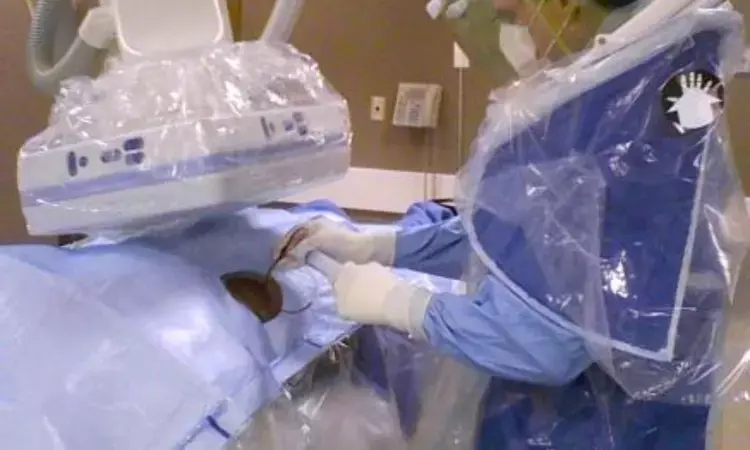- Home
- Medical news & Guidelines
- Anesthesiology
- Cardiology and CTVS
- Critical Care
- Dentistry
- Dermatology
- Diabetes and Endocrinology
- ENT
- Gastroenterology
- Medicine
- Nephrology
- Neurology
- Obstretics-Gynaecology
- Oncology
- Ophthalmology
- Orthopaedics
- Pediatrics-Neonatology
- Psychiatry
- Pulmonology
- Radiology
- Surgery
- Urology
- Laboratory Medicine
- Diet
- Nursing
- Paramedical
- Physiotherapy
- Health news
- Fact Check
- Bone Health Fact Check
- Brain Health Fact Check
- Cancer Related Fact Check
- Child Care Fact Check
- Dental and oral health fact check
- Diabetes and metabolic health fact check
- Diet and Nutrition Fact Check
- Eye and ENT Care Fact Check
- Fitness fact check
- Gut health fact check
- Heart health fact check
- Kidney health fact check
- Medical education fact check
- Men's health fact check
- Respiratory fact check
- Skin and hair care fact check
- Vaccine and Immunization fact check
- Women's health fact check
- AYUSH
- State News
- Andaman and Nicobar Islands
- Andhra Pradesh
- Arunachal Pradesh
- Assam
- Bihar
- Chandigarh
- Chattisgarh
- Dadra and Nagar Haveli
- Daman and Diu
- Delhi
- Goa
- Gujarat
- Haryana
- Himachal Pradesh
- Jammu & Kashmir
- Jharkhand
- Karnataka
- Kerala
- Ladakh
- Lakshadweep
- Madhya Pradesh
- Maharashtra
- Manipur
- Meghalaya
- Mizoram
- Nagaland
- Odisha
- Puducherry
- Punjab
- Rajasthan
- Sikkim
- Tamil Nadu
- Telangana
- Tripura
- Uttar Pradesh
- Uttrakhand
- West Bengal
- Medical Education
- Industry
Study reveals high prevalence of radiation-induced cataracts among radiation workers of interventional cardiology

Indonesia: A recent study published in the Journal of Clinical Interventional Radiology has shed light on the effects of ionizing radiation exposure on cataracts among radiation workers of interventional cardiology in Indonesia.
The study showed that the prevalence rate of radiation-induced cataracts among radiation workers of interventional cardiology was 16.7%.
The researchers identified a significant relationship between the estimated cumulative radiation dose, the risk of radiation-induced cataracts, and lens density. They revealed an association between increased cumulative radiation dose and increasing risk of radiation-induced cataracts and lens density. A significant relationship was also found between radiation protection use, the risk of radiation-induced cataracts, and lens density.
"Responsive use of ceiling-suspended shields and protective eyewear will lead to reduced risk of radiation-induced cataracts and lens density," Wida Setiawati, Department of Ophthalmology, Faculty of Medicine, Universitas Indonesia, Cipto Mangunkusumo Hospital, Jakarta, Indonesia, and colleagues wrote in their study.
A cataract is a haziness of the lens structure with multifactorial aetiology, including diabetes mellitus, age, genetics, use of steroid drugs, trauma, free radicals, and radiation exposure. The lens is one of the most radiosensitive tissues in the human body. Lens structure can be disrupted due to radiation exposure, especially ionizing radiation. Cataract is classified as a deterministic effect of radiation, which only appears when the radiation exposure dose limit is exceeded.
Among the most frequent fluoroscopy users in the medical profession are radiation workers of interventional cardiology. Consequently, they are vulnerable to radiation-induced cataracts. The researchers aimed to determine the prevalence of radiation-induced cataracts and its correlation with radiation exposure dose and radiation protection equipment use among radiation workers of interventional cardiology.
For this purpose, they conducted a cross-sectional and retrospective case–control study comprising 180 subjects. The prevalence of radiation-induced cataracts was assessed using Scheimpflug analysis on the Pentacam-Oculus device. Questionnaires and personal dosimeters were used to identify individual cumulative radiation exposure dose and radiation protection equipment use.
The study led to the following findings:
- The prevalence of radiation-induced cataracts was 16.7%.
- The median cumulative radiation dose was 0.8 Gy.
- There was a positive correlation between cumulative radiation dose and lens density (R Spearman = 0.64).
- 83.9% of subjects used ceiling-suspended shields for 71 to 100% of their working period.
- Most subjects (40.6%) did not wear protective eyewear.
- There was a statistically significant increasing risk of radiation-induced cataracts and unresponsive use of radiation protection equipment.
- Subjects using ceiling-suspended shields in only 31 to 50% of their working period increased their cataract risk by 10.8 times.
- Subjects using protective eyewear in only 51 to 70% of their working period increased their cataract risk by 8.64 times.
- Subjects who did not wear protective eyewear had an odd ratio of 164.3 compared to those who did.
"The findings showed that radiation-induced cataracts among radiation workers of interventional cardiology are dependent on the radiation exposure dose and the use of radiation protection equipment," the researchers concluded.
Reference:
The study titled, "Effects of Ionizing Radiation Exposure on Cataract among Radiation Workers of Interventional Cardiology in Indonesia," was published online in the Journal of Clinical Interventional Radiology. DOI: 10.1055/s-0043-1775854
Dr Kamal Kant Kohli-MBBS, DTCD- a chest specialist with more than 30 years of practice and a flair for writing clinical articles, Dr Kamal Kant Kohli joined Medical Dialogues as a Chief Editor of Medical News. Besides writing articles, as an editor, he proofreads and verifies all the medical content published on Medical Dialogues including those coming from journals, studies,medical conferences,guidelines etc. Email: drkohli@medicaldialogues.in. Contact no. 011-43720751


